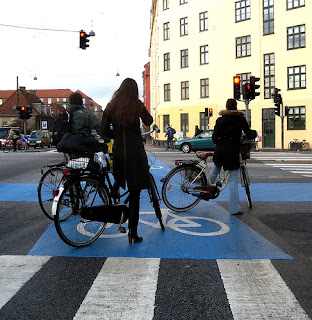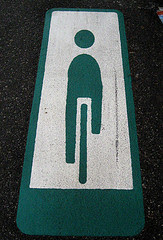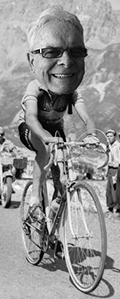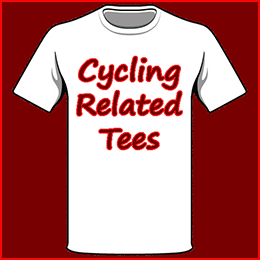Do separate bike paths improve safety?
 Wed, November 14, 2007
Wed, November 14, 2007 
She came flying up to the intersection; driving way too fast.
I could tell by her speed she wasn't going to stop, even though there was a stop sign. I touched my brakes and moved out to the center of the road near to the yellow line.
I could see there was no traffic coming towards me, and I already knew there was nothing immediately behind me.
Two things told me this: 1.) My ears; I could hear no vehicle behind me, and 2.) The fact that she was not intending to stop. She was looking right past me further down the road.
Had I not moved out to the center I would have run smack in the side of her. She saw me at the last second and slammed on the brakes; a little late because by now she was right out into the lane I had been riding in. She might as well have kept going because by this time I was over the yellow line and in the opposing lane completely out of her way.
Anyway, she stopped and let me pass, and I moved back over to the right. As she passed me slowly, I saw her passenger side window roll down and I was actually expecting an apology. She called out, "Why aren't you on the bike path?" There is a bike path that runs along side this road.
Somewhat taken back I hesitated for a second, then told her. "If I had been on the bike path you would have hit me for sure." I don't know if she even heard me because by now the window was rolling up again and she was speeding away.
I would have liked to explain that she had not intended to stop at road intersection, and was certainly not looking to see if there was anyone on the bike path before she came to the road.
Had I been on the path I could not have stopped in time because she came up so fast, and there was nowhere I could go to avoid hitting her. On the road I was at least able to move to the left and give her room.
I dislike this type of bike path. It gives the city planners the impression that they are doing the right thing to improve safety for cyclists. It gives the inexperienced cyclist the impression that they are safe, but are they?
On the road there is a remote possibility a cyclist will be run down from behind. However statistics show that this is the least likely accident that can happen. An accident is more likely to occur at an intersection; either someone pulling out of the side road, or turning into it, in front of a cyclist, or a vehicle passing the cyclist then side-swiping them as they turn. (The right-hook.)
Although the cyclist on the bike path has zero possibility of being run down from behind, they are at even greater danger at each intersection than if they were on the road, because they are less visible.
In addition, as I have demonstrated on the bike path there is no room for the cyclist to take evasive action. Then you have the added hazard as in this case a driver pulling up to the intersection and the cyclist runs into the side of the vehicle.
If planners are going to install this type of bike path, why not move the stop signs back behind the bike path, so at least in theory a vehicle will stop at the bike path then move slowly forward to the intersection.
The bike path crossing should be clearly marked on the road with lines and possibly the bike symbol. And what is a cyclist to do at every intersection? I'm sure the planners will say he should stop every time, but if bike rider is on the road he has the right of way to ride straight through the same as other vehicles. Personally, I would rather see bike lanes on the existing highway. Cheaper to install, and certainly easier to keep clean. It gets the bike rider used to riding in traffic, the cyclist is more visible, and it lets the car driver know that cyclists have a right to be there.
Personally, I would rather see bike lanes on the existing highway. Cheaper to install, and certainly easier to keep clean. It gets the bike rider used to riding in traffic, the cyclist is more visible, and it lets the car driver know that cyclists have a right to be there.
I like the idea they have in Denmark where the bike lanes are painted a different color at the intersection.(Picture above right.) Speaking of Denmark, yesterday’s post on Copenhagen Girls on Bikes explains their Green Wave System: “The 'Green Wave' system coordinates the traffic lights to give cyclists a 'green wave' all the way along the route.
“The 'Green Wave' system coordinates the traffic lights to give cyclists a 'green wave' all the way along the route.
This means that if you ride 20 km per hour (12.5 mph.) you'll hit green lights the whole way.
Some people have bike speedometers - not many - but most can adjust their speed using their experience, without electronic interference, and enjoy an uninterrupted ride to and from work.
Most of the stretches featuring the Green Wave have 15,000 - 30,000 bikes per day.”
Now that’s what I call bicycle friendly.
 Dave Moulton | Comments Off |
Dave Moulton | Comments Off | 

















Reader Comments (16)
And then I think that I am bloody lucky to live in a country that is not car centric like the USA and where the test and training required for a driver's license are very strict.
These are the people who think they should ride facing oncoming traffic so they can see it coming.
Question: What do you use to create your diagrams? I'll be commuting by bike soon, and would like the capability to easily generate such images. I can use Photoshop well enough, but it seems like so much work.
However, my reality often includes my young sons. We have no choice in riding around our neighborhood but to ride on streets that are four to eight lanes wide. Imagine being responsible for not only watching every vehicle but also how every vehicle attempts to deal with young riders.
My sons are well trained and are constantly criticizing the numerous law violations being committed by drivers. We have even had SUV drivers run us off roads and law enforcement remains unconcerned and ineffective.
We need wider lanes, bike lanes, and other infrastructure that reminds drivers of their responsibilities. In our area though, local city planners have narrowed road lanes to 11 feet in order to add an additional lane for cars-trucks.
My sons ride to school daily and they are well aware that walk signs are dangerous since cars and buses often run right through the intersections.
Every cyclist should know the risks of intersections and ride accordingly. USA drivers should have to pass driving tests with much higher standards. Even truck drivers' licences are sold to unqualified drivers in IL to finance a governor's reelection.
Jack
Traffic engineers should actually climb onto bicycles and spend a day or two riding with experienced bike commuters who can give them some first-hand advice and experience about what works for cyclists and what doesn't.
I have personally discussed this idea with engineers who said it was a great idea ... and then they never bothered to actually do it.
Those cars are so warm and comfortable, you know.
Also, I love the idea of making all officials who make transportation policy and all traffic engineers ride a bike on the roads they engineer.
Ride defensively!
"A separate bike path SHOULD improve safety for both bicyclist and auto- truck operator."
In observed practice, BOTH bicyclist and vehicle operators are typically at odds with one another.
Bicyclist, motorcyclist AND auto-truck operator MUST observe basic 'rules of the road' and NOT become yet another accident statistic!
Notice I termed these persons 'operators' NOT drivers, there lay multiple observable problems with individuals and their vain attempts at guiding a vehicle of any type.
Time for a valid, uniform, NATIONAL test for ALL vehicle operators of ANY age!
I don't blame any individual as government, industry and society are the farmer 'sowing this demon seed'.
We have many separate paths that are two-way, so you have bicycles going against the flow of traffic, and they allow cars to cross over onto private as well as public street intersections.
Look at Palm Springs: cement bike paths on one side of the road, bikes going both directions, with business and private driveways as well as roads intersecting. So you have bikes coming from both directions as cars and bikes converge on those intersections.
Not only do you have to stop at almost every intersection, you also have to be aware of the tourists coming at you. Not conducive to a good ride.
Me, I ride on the street even if a separate bike path is provided. It’s not illegal and a hell of a lot safer.
the images from this ad campaign are worth a look
the worst case scenario is everyday
all the time
what amazes me
is that people travel their commuter routes every day
never anticipating the obstacles
the bike path is there
you would think that they would look for runners or cyclists on the path before getting to the intersection
but alas
there are more important things on their minds than human life or the rights of others
There's another intersection I cross daily that I almost expect this behavior.
Dave, thanks again for a great blog post!
I must admit I also like the addressing of the fact that most cyclists do not have speedometers. This is refreshing to hear considering they give out speeding tickets on some of the trails out here.
So many contradictions in logic.
I'd have to disagree with bikes using the same slab of tarmac as cagers. I've had too many close calls. I also know that intersections will always be danger zones, whether on a bike, driving a car or even driving an 18-wheeler (which I do). Lots of folks are just plain stupid.
I found this well-put-together video doc called "The Case for Separated Bike Lanes in NYC," but it can apply to any roadway or higher density area where bicycles, as a method of alternative transport is used or desired:
http://www.youtube.com/watch?v=ONS2ptAR4mo
I'll almost always take a bike lane in heavy traffic areas. Only a reckless cyclist would ride through that intersection in your example unless there was a very clear view of traffic from all directions.
One dangerous thing I see here is bike lanes on the wrong side of the road (like a two direction cycle path on one side of thr road.
This makes intersections even more dangerous as car drivers have no habit of expecting something cming from that direction on the wrong side of thr road.